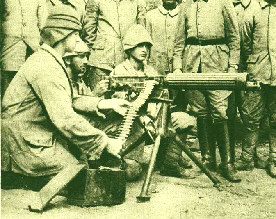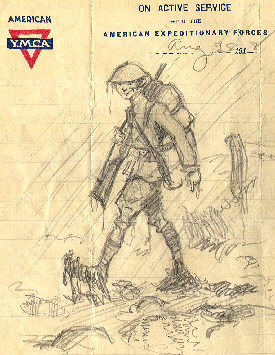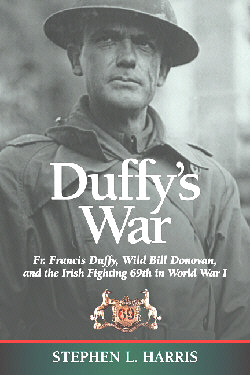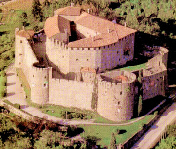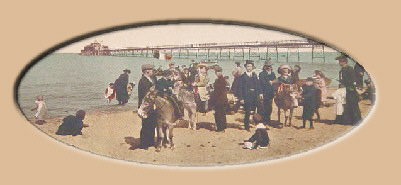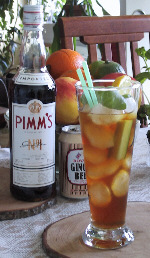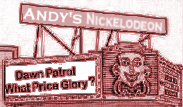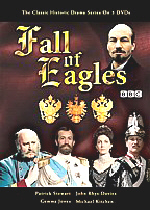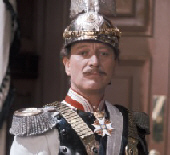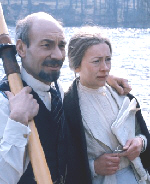
August 2006 |
Access Archives |
|
TRENCH REPORT: A little Trip-Wire administrative news to start out. You may have heard that I will be stepping down from the Board of Directors of the Great War Society later this month. They have asked me to continue to edit their website which is agreeable to me. However, since the Trip-Wire is targeted to the entire community of World War I scholars, researchers, enthusiasts and buff, we will be publishing this newsletter in the future under the banner of the legendary, ground breaking Trenches on the Web site founded by the late Mike Iavarone. I assure you we will continue to report the doings of all the organizations furthering interest in the events of 1914-1918. Our new address will be well publicized when the changeover occurs so you can bookmark it. . .Big news for our Midwestern readers: The Western Front Association has announced a new chapter for the region which will be centered around the National World War I Museum at the Liberty Memorial in Kansas City. I've met with the new Chairman George Thompson who is planning an ambitious series of programs in conjunction with the Museum. Contact George if you have any interest in joining or supporting the new chapter. (link)
MH British Prime Minister David Lloyd George
|
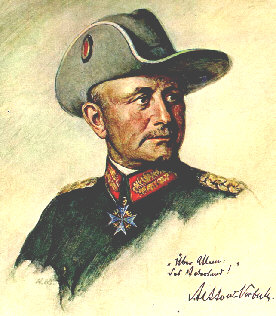
German War Hero |
||||||||||||||||||
GREAT WAR 2006 EVENT CALENDAR | |
|
90th Commemorative Events Comprehensive Double Calendar Scheduled Throughout 2006 (link) | |
|
Hilton Garden Inn, Tampa North August 16 (link) | |
|
Cleveland Gray's Armory October 21st (link) | |
|
UCLA, October 12-14, 2006 Los Angeles, CA (email for details) | |
|
Hartford, Connecticut November 11th (Program) | |
|
An International View of the Great War With our Friends Jean- Pierre & Cecile Mouraux Sonoma, California Check back for Details November 11th | |
|
Email Response |
|
|
News on Two Canadian Projects: Producers of this Canadian Broadcasting Company-Galafilm TV project have recruited 150 descendants of Canadian Expeditionary Force (DEF) veterans to reenact for the cameras the trench warfare of WWI. The broadcast of this program in two segments will be timed to coincide with the 90th anniversary in April next year of the Battle of Vimy Ridge, the great CEF victory. Filming will be done at an army range outside Montreal in July 2007. The program is written and directed by Brian McKenna.
Reenactors for the film were selected from among 6.500 applicants, all of whom had family members in the CEF of 1914-1918. Reenactors will spend the entire two weeks of filming in tents or trenches eating WWI-style rations (bully or corned beef, bacon and beans)and wearing scratchy khaki uniforms and puttees.
The producers of the Canadian motion picture "Passchendaele" are still seeking public and private financing to start filming this C$17 million epic. The Flanders battlefields were 50 thousand Canadians fought during the Third Battle of Ypres in 1917 will be recreated in Alberta. The film, directed by Canadian actor Paul Gross, will employ some 50 to 75 actors and hundreds of extras. Release is planned for November 11, 2007 to coincide with Canadian Remembrance Day.

Von Moltke's success in the wars of German unification, as well as in the Franco-Prussian War, greatly colored German thinking in the run-up to World War I. Alfred von Schlieffen believed that "the flank attack is the gist of the entire history of war" and banked everything on it. With unfortunate intellectual disdain the British railed against "a cult of any particular form of action," and many advocated a "doctrine of no doctrine." French doctrine proclaimed, "The French Army recognizes no law save that of the offensive." The German operational concept proved to be overreaching, and the Allies found that operational concepts -- or the lack thereof -- really do matter.
From: That Elusive Operational Concept, June 2001
By Col. David A. Fastabend, AUS
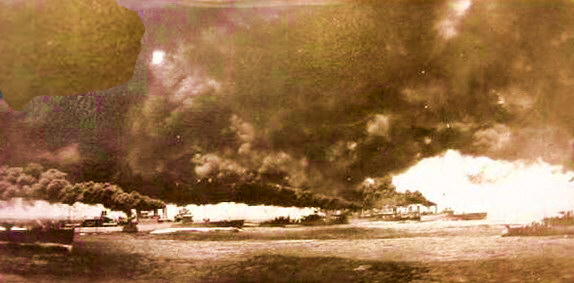
North Sea Mine Barrage Flotilla Laying a Smoke Screen After Submarine Alarm
Photo by USN Diver Larkin Brown Aboard USS Aroostook
 |
Pvt. Raymond Pierson Jones |
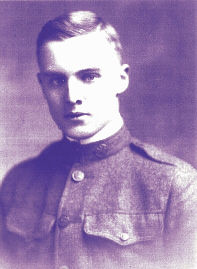 |
"A number of enlistments for the United States army were received at the recruiting station Tuesday. Raymond Jones, a former Wiley [high school football star and a sophomore at [Rose Poly[technique] enlisted for the aviation section of the signal corps and was sent to Jefferson Barracks, Mo. at once."
Throughout his life he was known as "Pierson" which was his mother's family name. There is a record of military service in the Pierson family. My Dad's grandfather, Josiah Pierson, enlisted in Co. C, 85th Indiana Volunteer Infantry in the Civil War. His g-g-grandfather, Moses Pierson, served as a "Waggoner" from NJ in the American Revolution. His father and grandfather on the Jones side had no military service.
In the First World War, Pvt. Jones served in both the 485th Aero Construction Squadron (ACS) and the 489th ACS. The 485th ACS departed the US from the Aviation Concentration Camp at Morrison, VA on 4 March 1918 on the LTSS Madawaska, landing at St. Nazaire, FR 21 March 1918 and was stationed at Romorantin, Loir-et-Cher, FR, at the Air Service, Production Center No. 2.
He was transferred to the 489th ACS on 30 April 1918 and remained with that unit until his discharge at Camp Zachary Taylor, KY, 28 February 1919.
Following his army service in the AEF, he entered the lumber and building material business and was president of the Armstrong-Walker Lumber Co., Terre Haute, IN at his death 23 July 1959. Dad didn't ever talk much about his time in the army except to tell a few funny stories and I was too young and busy to ask until it was too late. I learned more about his service from the letters he wrote home to his mother, sister and father, which luckily his mother saved. This information is furnished by his son Thomas Pierson Jones, Major General, AUJS, Retired; from PVT Jones's discharge, DD Form 303A, his record of service Form No. I 'A, A.G.O. and unit records found in the Nation Archives and Records Administration in College Park, MD. The Rose Polytechnique Institute, located in Terre Haute, IN, is now known as Rose-Hulman Institute of Technology, is among the top ten engineering colleges in the country.
|
Verdun |
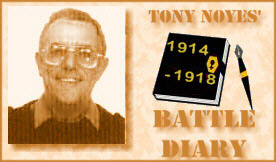 |
The Somme | |
Using the 37th African Division, Mangin had launched a counter attack against
the Germans at Fleury village in the middle of July.
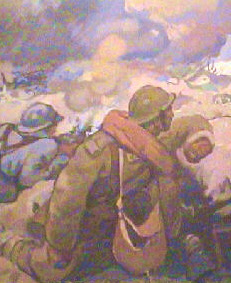 Poilu and French Colonial |
Haig closed down the battle west of the Ancre river. No advance had been made in this area at all in July and he now concentrated on a series of operations in the eastern sector. Officially there are 12 separate battles within the overall "Battle of the Somme", some spreading over five and six weeks.
Click Here to See a Large
|
|
Somme-August continued:
The result was that a section of the chess board had to be attacked many times over the same ground into the same gunfire, usually with the same macabre results. This, on occasions, produced the appalling need for men to advance over ground they had previously traversed, stepping over their own rotting dead whom they had known in life not long before. Equally, the defenders suffered from the incoming British artillery barrages and Ernst Jünger wrote in his book Storm of Steel of the quarry at Guillemont in August: the ground all round as far as the eye could see was ploughed by shells and you searched in vain for one blade of grass. This churned up battlefield was ghastly, and among the living lay the dead. As we dug ourselves in we found them stacked in layers on top of each other. One company after the other had been shoved into the drumfire and steadily annihilated. The corpses were covered with masses of earth turned up by the shellfire, and the next company advanced in place of the fallen. There seemed to be no way to break the deadlock. But; the tanks were coming! |
|

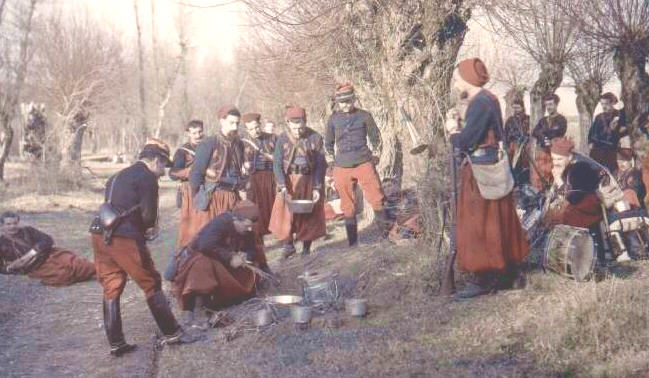
Zouaves at Meal Time
|
in the 21st Century |
|

|
Tomorrow [July 1st] |
(Originally published at the Nakedauthors.com blog on June 30, 2006)
Bear with me while I linger on this subject again, because for me today and tomorrow are days to reflect upon. Ninety years ago today, Jack Winspear, 27, was "somewhere in France," marching along a hastily prepared road on his way to the Somme Valley. Having enlisted for service in 1914, he had already seen most of his mates killed at Ypres and at Ploegsteert Wood - "Wipers" and "Plugstreet Wood" as the soldiers called them. Most of his battalion had been decimated at Ypres, so he had been placed on stretcher-bearer duty before being assigned to a new division, only for there to be the same outcome. And so it went on.
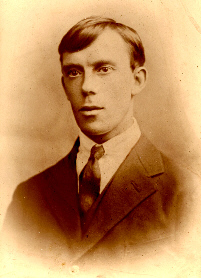 Jack Winspear at the Time of the War |
My grandfather came home from the war, put away his medals and barely spoke of what he had seen and done, shunning any questions by leaving the room. But my father managed to weasel a few quickly-recounted memories from him. Those stories were branded into me young by a curiosity that matched my father's when he was a boy. Grandad told my father about waiting his turn to step onto the ladder that led from the trench and onto the battlefield. With a ration of rum still warm on his breath, along with his mates he was waiting for the whistle, the signal to go "over the top' before running towards the enemy with bayonets fixed. How he was supposed to run, I don't know, because he would have had a pack on his back weighing at least 68lbs. But run he did, and on that day, in the early hours of the Battle of the Somme, it was straight into hell. Within minutes he was hit, the shell knocking him up into the air and onto the bodies of fallen comrades. With the screams of dying men around him, after hours and hours of waiting for the stretcher-bearers to come, he eventually listed into unconsciousness and woke up days later in a military hospital.
The Battle of the Somme, which began on July 1st, 1916, will be discussed and debated by military minds, historians and social scientists for decades to come, not least because of its continuing relevance. Winston Churchill said that with the Great War came humankind's realization that it could obliterate itself completely. This was never more true than at the Battle of the Somme. A short excerpt on the flyleaf of a new book about the battle by the distinguished historian, Martin Gilbert, speaks volumes: "In just 138 days of fighting, an average of more than 2,000 men per day were killed, 310,000 in all. The Allied forces lost nearly 150,000 men. And not one of the Allied objectives of the first day was reached."
But stats are stats and soon any connection with the suffering of another human being is replaced by a number, whether it's the dead in Somalia, the dying in Darfur or Gaza or Iraq, New Orleans. Jack suffered crippling wounds to his legs, and was shell-shocked and gassed in various battles of the First World War. I was aware of his disabilities from childhood, and I've written stories about how his wounds inspired my curiosity about that war. But there's one story I have never told, mainly for fear of it being misunderstood, and my dear grandfather being considered in a poor light, without compassion. And I loved that kind, gentle man too much for that to happen. But I will tell it now, and probably never again.
I was born in rural Kent, England, to parents who "escaped" post-WW2 London after they were married in 1949, and then who, for various reasons, decided to return when I was a toddler. That return didn't last long, because after ten months of living with my grandparents, they couldn't wait to get back to Kent. I think my unhappiness had a lot to do with it, because I was a country kid already used to fields and farmland. In London, while my parents were at work all day, I was left in the care of my grandparents. Grandad was only about 69, but years of pain and a compromised respiratory system made him seem much older. I was a high energy child used to an endless playground, so I know I must have been unbearable in London, because I can remember the velocity with which I would race to the park, past bombsites and still-broken buildings, when my mother came home from work.
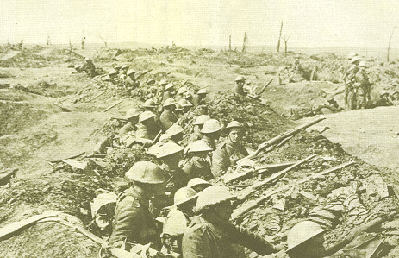
British Troops at the Somme Waiting to Advance
My grandmother made a fuss of finding a dressing for my doll's forehead, and pronounced her "all better." When satisfied that I was settled, she went to her husband, who was paralyzed by what had come to pass. I remember the feeling that enveloped me, even then - it was a sense of his despair.
I bore no lasting wound, in the way that child psychologists might suggest, though as I grew older I wanted to know more about the events and memories that shaped such despair, and what terrors from his soldiering days had been triggered anew by a child's unleashed energy. I reached adulthood with everything I understood about the broad and deep human cost of conflict weighing heavy on my heart. In Grandad's war hundreds of thousands of families in Britain, Canada, Australia, New Zealand, Ireland, South Africa, France, Belgium, Germany, India, Nepal - the list goes on - were impacted by that one battle. Jack Winspear marched to the Somme Valley 90 years ago, little knowing how his experiences might affect the family that was yet to be, and never in the world dreaming that a granddaughter named for him would write about it one day.
I have on my desk the base of a shell found in a field close to Serre in the Somme Valley. It would have been filled with shrapnel ready to kill and maim upon impact. Today it is polished to a shine, and now holds my pens.
If you are further interested in the subject of this blog, here are some links and books for you:
- London's famous Imperial War Museum has launched its first on-line exhibition on The Somme: http://www.iwm.org.uk/server/show/nav.00o
- Historian Andrew Robertshaw explains why The Battle of The Somme is of such interest today:
http://news.bbc.co.uk/go/em/fr//2/hi/uk_news/england/manchester/5083196.stm
- You can read my essay on my pilgrimage to the battlefields of the Great War, as the First World War is known:
http://jacquelinewinspear.com/essays_604.htm
And though my shelves are filled with books about the war, here are two "highly recommended" on The Battle of The Somme, both written by historians whose main interest is the human cost, and human experience of war:
- Somme by Lyn MacDonald (pub: Michael Joseph)
- The Somme by Martin Gilbert (pub: Henry Holt)
Michael Hordern serves as the unseen series narrator. The exceptionally gifted large cast can be divided into the various houses. The Romanovs and other Russians include Tony Jay (Tsar Alexander II), Charles Kay (Tsar Nicholas II), Gayle Hunnicutt (Tsarina Alexandra), Michael Aldridge (Rasputin), Frederick Alexander (Tsarevich Alexis), John Phillips (Grand Duke Nicholas), Kenneth Colley (Father Gapon), Michael Bryant (Ratchkowsky), Hugh Burden (Protopopov), Patrick Stewart (Lenin), Michael Kitchen (Trotsky) and Jim Norton (Kerensky). The stand outs here are Charles Kay and Gayle Hunnicutt as the Tsar and Tsarina, Patrick Stewart as Lenin and Michael Bryant as Ratchkowsky. The Hapsburgs and Austrians include Miles Anderson (Young Franz Josef of Austria-Hungary), Laurence Naismith (Emperor Franz Josef I of Austria-Hungary), Peter Woodthorpe (Archduke Franz-Ferdinand), Pamela Brown (Archduchess Sophia), Susan Tracy (Crown Princess Stephanie of Austria), Ann Castle (Grand Duchess Sergei), Rachel Gurney ('Sisi', Empress Elizabeth of Austria), Diane Keen (Young 'Sisi', Empress Elizabeth of Austria) and Irene Hamilton (Baroness Vetsera). Episode 4 "Requiem for a Crown Prince" covering the suicide and murder of Archduke Rudolf and Mary Vetsera at the hunting lodge Mayerling, show Laurence Naismith, Rachel Gurney and Irene Hamilton at their best.
The French and English are represented by John Bennett (Georges Clemenceau), Tom Criddle (Foreign Secretary Sir Edward Grey), Mavis Edwards (Older Queen Victoria), Perlita Neilson (Younger Queen Victoria), Frank Thornton (Prince Albert of England) and Derek Francis (Edward VII of England). The sets are magnificent with many of the great stately manor houses of England substituting for the various European palaces. The costumes are incredibly detailed and lavish. Released by Koch Vision on 4 DVDs at a list price of $49.98 it is readily available at discounts when ordered on-line. The running time is 10 hours, 50 minutes. Bonus features include interviews with Charles Kay (Tsar Nicolas II), Gayle Hunnicutt (Tsarina Alexandra) and David Cunliffe, director on 3 episodes and a Photo Gallery. Overall the picture quality is excellent, although some episodes are not as sharp as others. The sound is in Dolby Digital but there are no subtitles which would have been helpful. The British DVD release included a 40 page informative booklet with a family tree which is not found in the US release.
When I saw Michael E. Rosenberg, President of Koch Entertainment, at the Video Software Dealers Association annual trade show in Las Vegas in July, 2005, I described Fall of Eagles as the missing "Holy Grail" for Great War history buffs. Well, it's missing no longer- buy yourself a copy and enjoy this masterful dramatic presentation of European history. (link) Andrew Melomet, Proprietor of Andy's Nickelodeon will answer your Great War film or video inquiry. He is also soliciting your recommendations for the WWI Filmography he is compiling for our readers. Just click HERE. |
| The following are thanked for their contributions to this issue of the Trip Wire:Stephen Harris, Tom Jones, Bob Denison, Shawnee Brown, Tony Noyes, Esther MacCallum-Stewart, Andy Melomet, Len Shurtleff. Until next month, your editor, Mike Hanlon. |
Membership Information  Click on Icon |
SUBSCRIBE TO THE TRIP-WIRE (Or Send it to a friend.) (Or send us a comment on the TRIP-WIRE) CLICK HERE TO CONTACT US VIA EMAIL |
For further information on the events of 1914-1918
visit the Directory Page of |
